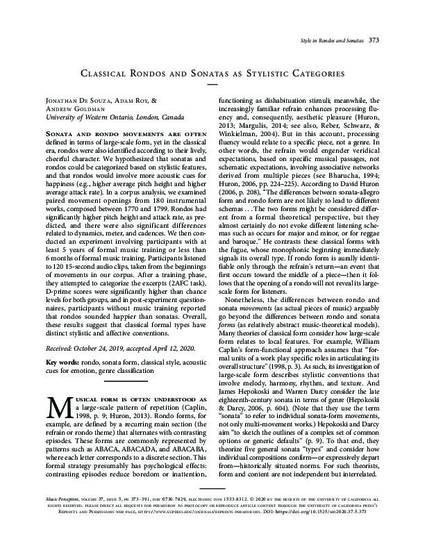
Article
Classical Rondos and Sonatas as Stylistic Categories
Music Perception
(2020)
Abstract
Sonata and rondo movements are often defined in terms of large-scale form, yet in the classical era, rondos were also identified according to their lively, cheerful character. We hypothesized that sonatas and rondos could be categorized based on stylistic features, and that rondos would involve more acoustic cues for happiness (e.g., higher average pitch height and higher average attack rate). In a corpus analysis, we examined paired movement openings from 180 instrumental works, composed between 1770 and 1799. Rondos had significantly higher pitch height and attack rate, as pre- dicted, and there were also significant differences related to dynamics, meter, and cadences. We then con- ducted an experiment involving participants with at least 5 years of formal music training or less than 6 months of formal music training. Participants listened to 120 15-second audio clips, taken from the beginnings of movements in our corpus. After a training phase, they attempted to categorize the excerpts (2AFC task). D-prime scores were significantly higher than chance levels for both groups, and in post-experiment question- naires, participants without music training reported that rondos sounded happier than sonatas. Overall, these results suggest that classical formal types have distinct stylistic and affective conventions.
Keywords
- rondo,
- sonata form,
- classical style,
- acoustic cues for emotion,
- genre classification
Disciplines
- Music,
- Music Theory and
- Psychology
Publication Date
2020
DOI
https://doi.org/10.1525/MP.2020.37.5.373
Citation Information
Jonathan De Souza, Adam Roy and Andrew Goldman. "Classical Rondos and Sonatas as Stylistic Categories" Music Perception Vol. 37 Iss. 5 (2020) p. 373 - 391 Available at: http://works.bepress.com/jonathan-desouza/11/
